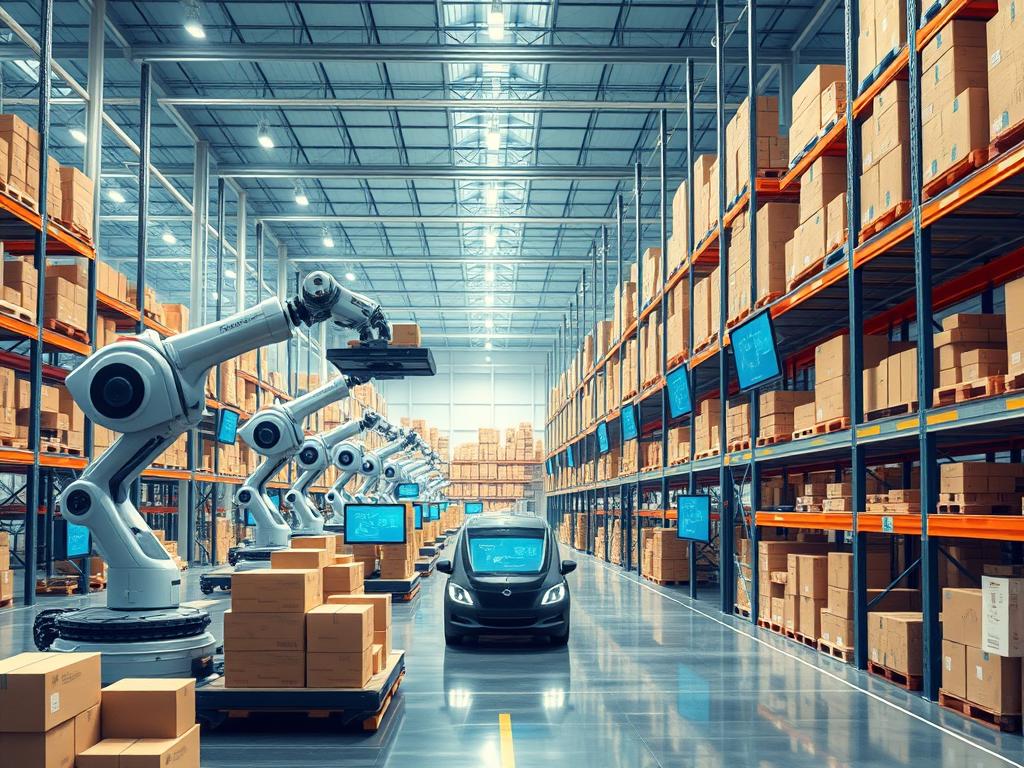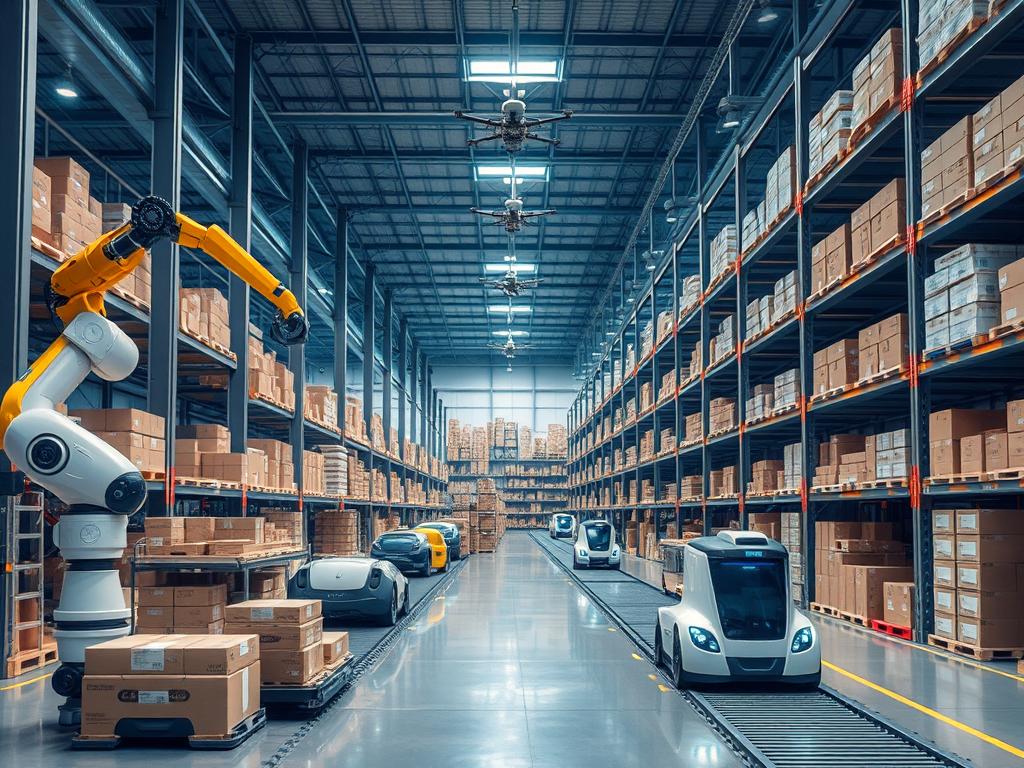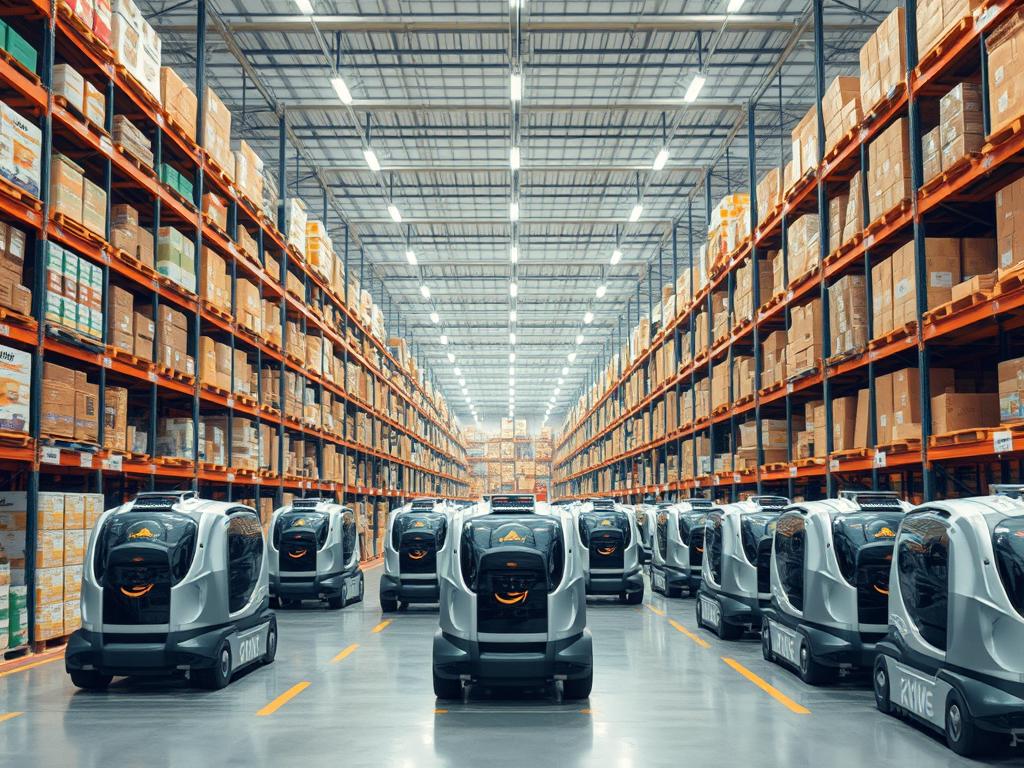The warehouse automation market is set to hit $41 billion by 2027. This growth shows the impact of warehouse automation solutions on logistics and supply chains. Automation has evolved from simple tools to complex systems.
Warehouse automation has seen major changes over time. The 1960s brought in Automated Storage and Retrieval Systems (AS/RS). These systems improved storage and efficiency. Computerization also began with early Warehouse Management Systems (WMS).
Today, we’re in a new phase of automation. The Internet of Things (IoT) and artificial intelligence (AI) are transforming warehouse operations. These technologies are changing how supply chain decisions are made.
The benefits of these innovations are clear. Crutchfield, an online electronics retailer, improved its picking rate by 25%. This upgrade saved them $250,000 annually. Such results are driving more companies to adopt warehouse automation.
This guide will explore key warehouse automation technologies. We’ll look at AS/RS, conveyor systems, and RFID. You’ll learn how these tools boost efficiency and productivity. We’ll also cover implementation strategies to help you succeed.
Understanding Warehouse Automation Solutions
Warehouse automation is changing logistics. It uses technology to boost efficiency and streamline operations. By 2026, the global market will hit $33.34 billion, growing 13.60% yearly.
What is Warehouse Automation?
Warehouse automation uses tech to reduce human tasks. It includes basic conveyors and advanced robotics. These systems improve productivity, accuracy, and safety in warehouses.

Key Components of Warehouse Automation
The core of warehouse automation includes several key technologies:
- Automated Storage and Retrieval Systems (AS/RS)
- Automated guided vehicles (AGVs)
- Robotic picking systems
- Automated conveyor systems
- Warehouse Management Systems (WMS)
These parts work together for smooth operations. AGVs use advanced controls to move goods without humans. They navigate warehouse floors efficiently.
Benefits of Automation in Warehousing
Warehouse automation offers many advantages:
- Increased productivity and throughput
- Enhanced accuracy (up to 99.9% with AS/RS)
- Improved space utilization
- Real-time inventory tracking
- Reduced operational costs
- Enhanced worker safety
iHerb, an online health retailer, shows automation’s power. They process over 40,000 orders daily with same-day shipping. This efficiency meets modern consumer demands.
Types of Warehouse Automation Technologies
Warehouse automation technologies have transformed the logistics industry. They boost productivity and cut costs significantly. The market is expected to reach $30 billion by 2026, up from $17.9 billion in 2022.
Automated Guided Vehicles (AGVs)
AGVs are changing how warehouses handle materials. These robotic vehicles move goods along set routes efficiently. The AGV market is growing fast, with a projected 15.8% CAGR from 2019 to 2025.
Robotic Picking Systems
Robotic pickers, like Amazon’s Sparrow, automate item selection. They work with warehouse control systems to improve speed and accuracy. Collaborative robots can boost efficiency by 30% in modern warehouses.
Warehouse Management Systems (WMS)
WMS software is crucial for warehouse operations. It works with automated sorting and voice-directed systems to manage inventory better. This leads to lower labor costs and improved efficiency.
Conveyor Systems
Companies like UPS use conveyor systems to move goods quickly. These systems often work with other automation tech for smooth warehouse operations.

Together, these technologies boost warehouse productivity by 25% to 70%. They also cut operating costs by 20% to 40% by 2025. As the industry grows, we’ll see more integration for even better efficiency.
Implementing Warehouse Automation: A Step-by-Step Approach
Warehouse automation is changing how logistics work. A 2024 Gartner survey shows 74% of supply chain pros use cyber-physical systems. This trend is seen in grocery, automotive, and e-commerce industries.
Assessing Your Current Operations
Start by looking closely at your warehouse. Check your operations, layout, SKUs, turnover rates, and work cycles. This helps find where warehouse execution systems can improve productivity and safety.
Setting Clear Objectives and Goals
Decide what you want to achieve with automation. You might aim to increase order accuracy or cut labor costs. IDC notes that labor costs in these projects are often underestimated by 50%.
Selecting the Right Technologies
Pick tech that fits your warehouse size, budget, and goals. Automated storage and retrieval systems (AS/RS) can make storage more efficient. The Pallet Shuttle system, for example, boosts efficiency in various warehouse sizes.
Training and Change Management
Make changes slowly, starting with a test run. Train your staff well and watch how things improve. Work with everyone involved to make sure the changes work.
| Automation Type | Benefits | Example |
|---|---|---|
| Material Handling | Improved efficiency | Conveyors, AGVs |
| Storage | Optimized space use | AS/RS, Pallet Shuttle |
| Picking and Packing | Increased accuracy | Robotic arms |
| Inventory Management | Real-time tracking | RFID systems |
Following these steps can greatly improve warehouse operations. The warehouse automation market is expected to reach $30 billion by 2026. Now’s the time to use these new solutions in your warehouse.
Real-Life Examples of Warehouse Automation
Warehouse automation has transformed the logistics industry. Top companies use cutting-edge tech to streamline operations and boost efficiency. Let’s explore how they do it.
Amazon’s Fulfillment Centers
Amazon leads in warehouse automation with over 200,000 mobile robots. Their centers use warehouse management software to optimize picking, packing, and shipping.
This results in super-fast order processing and delivery times. Customers keep coming back for this speedy service.

Walmart’s Automated Distribution Centers
Walmart has made big moves in automation. Their centers use automated guided vehicles (AGVs) and fast sorting systems.
They also use AI for inventory management. This ensures quick product replenishment. As a result, Walmart has improved accuracy and speed in handling products.
Impact on Smaller Warehouses
Smaller warehouses benefit from automation too. Crutchfield, for example, uses robotic picking systems. This has boosted their efficiency and cut operational costs.
Decathlon increased storage capacity by 20% with automated mobile robots. They also use goods-to-person robots to improve operations.
| Company | Automation Technology | Key Benefit |
|---|---|---|
| Amazon | Mobile Robots | Faster Order Processing |
| Walmart | AGVs & AI | Improved Inventory Management |
| Crutchfield | Robotic Picking Systems | Increased Efficiency |
| Decathlon | AMRs | 20% Increase in Storage Capacity |
These examples show how versatile and scalable warehouse automation is. It works for big and small businesses alike.
Smart tech is changing the game in logistics and supply chain management. It’s helping companies stay competitive in a fast-paced world.
Future Trends in Warehouse Automation Solutions
Warehouse automation is changing fast. New tech is reshaping supply chain operations. Several key trends are set to revolutionize the industry by 2025.
Advancements in Artificial Intelligence
AI will be crucial in warehouse automation trends. By 2025, AI will boost decision-making and order accuracy in warehouses. UPS has already seen big gains by using AI.
Many warehouses plan to invest more in AI. This trend is expected to grow rapidly in the coming years.
The Role of IoT in Warehousing
IoT devices are becoming key in modern warehousing. Smart sensors enable real-time tracking and data analysis. This improves inventory management and efficiency.
Voice-directed warehousing, powered by IoT, is gaining popularity. It allows hands-free, eyes-up operations, boosting productivity and accuracy.
Sustainability and Eco-Friendly Solutions
Warehouses are focusing more on sustainability. Companies are using eco-friendly tech to cut energy use and waste. Packsize, for example, helps reduce packaging waste.
Green automation is both good for the planet and cost-effective. It’s a win-win for businesses and the environment.
Preparing for Workforce Changes
Automation is changing warehouse jobs. By 2025, there will be more focus on training workers to use advanced tech. Cobots may double productivity in some warehouses.
This shift lets humans focus on strategic tasks. Meanwhile, automated sortation systems handle routine work. Many warehouse managers plan to spend more on automation and robotics.
Preparing workers for this tech shift is crucial. It will help ensure a smooth transition to the automated future.


